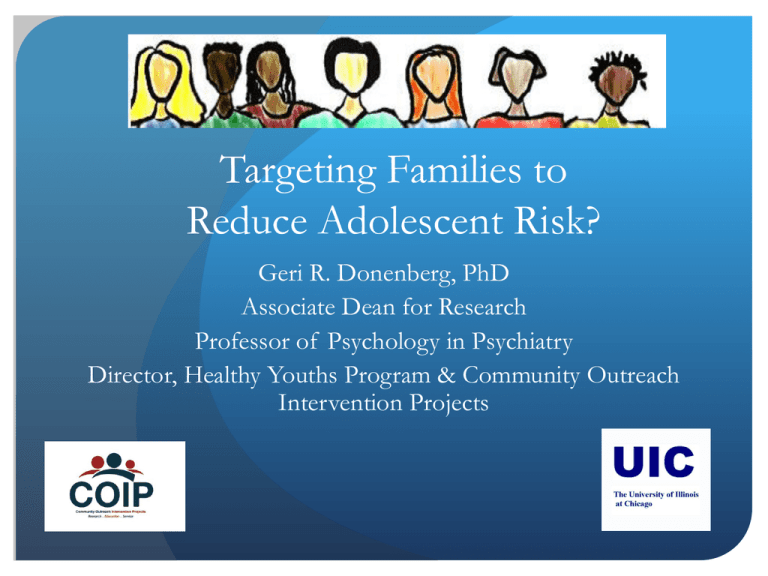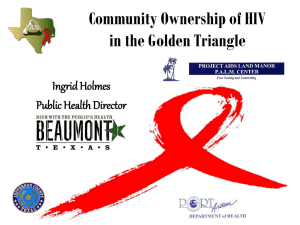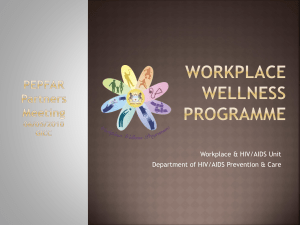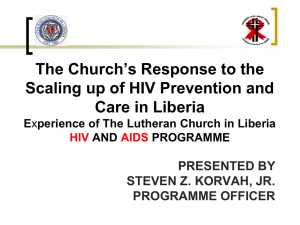
Targeting Families to
Reduce Adolescent Risk?
Geri R. Donenberg, PhD
Associate Dean for Research
Professor of Psychology in Psychiatry
Director, Healthy Youths Program & Community Outreach
Intervention Projects
HIV/AIDS Risk Among Youth in the US
Young people 15–24 years represent 25% of the
sexually experienced population, yet acquire nearly
50% of all new STIs annually (CDC, 2009)
✦ Most teens acquire HIV through risky sexual
behavior (CDC, 2009)
✦ Health disparities are prominent
✦
✦
✦
✦
half of
Men who have sex with men
African Americans
African American females
✦
✦
✦
African American women represent 63% of all women with AIDS in the US;
Nearly 80% of all women with AIDS in Chicago are AA
44% of AA girls have an STI (Forhan et al., 2009)
HIV/AIDS Risk Among Youth in the US
Young people 15–24 years represent 25% of the
sexually experienced population, yet acquire nearly
50% of all new STIs annually (CDC, 2009)
✦ Most teens acquire HIV through risky sexual
behavior (CDC, 2009)
✦ Health disparities are prominent
✦
✦
✦
✦
half of
Men who have sex with men
African Americans
African American females
✦
✦
✦
✦
African American women represent 66% of all new HIV infections among
women in the US;
Nearly 80% of all women with AIDS in Chicago are AA
New data indicate rates among AA women rival South Africa (1 out of every 32
black women will be infected with HIV during her lifetime)
44% of AA girls have an STI (Forhan et al., 2009)
New Technologies
Facebook
Sexting
YouTube
Hook-up websites
Formspring
Photobucket
A Girl’s Nude Photo and Altered Lives
(New York Times, March 26, 2011)
Kathy, 17, Queens: “There’s a positive side to sexting. You
can’t get pregnant from it, and you can’t transmit S.T.D.’s. It’s
a kind of safe sex.”
Can families influence mitigate
adolescent HIV risk?
Social Personal Theoretical Model
Cognitions (AIDS
knowledge, attitudes,
beliefs, self-efficacy)
Affect
Regulation
Mental Health/
Substance use
Sexual
Abuse
Personality Traits (sensation
seeking, value on health,
achievement motivation)
Personal
Attributes
Risky Sex
(condom use,
multiple
partners,
early debut)
Crime
Environmental
Stress
Peer and
Partner
Relationships
Environmental
Conditions
HIV Risk
IV Drug Use
Poverty
Peer
Influence
Family
Context
Parental
Attitudes
and
Behavior
Affective
Characteristics
(warmth,
hostility)
Instrumental
Characteristics
(control,
discipline)
Relationship
Concerns (fear of
rejection, fidelity
management, need
for intimacy)
Parent-Adolescent
Communication
(general topics,
sexual topics)
Partner
Communication
(Donenberg & Pao, 2005)
Study Samples
(N=346): 12-19 years old (M=16); 55% female; 40%
Caucasian; Outpatient mental health clinics; B, 6- and 12-months
(N=266): 12-16 years old (M =14.5); 100% female and African
Americans; Outpatient mental health clinics; B, 6-, 12-, 18-, 24-months
(N=721): 13-18 years old (M=14.8); 57% female; 63% Black;
Inpatient and outpatient mental health settings; 3-site, 3-arm RCT; B, 6-,
12-, 24-, 30-, 36-months
Family Context and HIV Risk
Family Context
Instrumental
Characteristics
Affective
Characteristics
Parent-Teen
Communication
Donenberg et al. (2002) AIDS
Education and Prevention
Risky Sexual Behavior
4
Females
3
2
Males
1
0
Low
High
Perceived Parental Permissiveness
Hadley et al. (2011) J of Family Psychology
Donenberg et al. (2011) JCCP
African American girls who reported ever
having vaginal/anal sex were more likely to
report:
More permissive parenting
Less parental monitoring
Family Context and HIV Risk
Family Context
Instrumental
Characteristics
Affective
Characteristics
Parent-Teen
Communication
Emerson et al. (in press) J of Family Psychology
.41***
Mother-Daughter
Attachment
-.03
.27***
***p < .001
Peer
Attachment
-.06
Risky
Sexual
Behavior
-.14
Peer
Norms
.57***
Donenberg et al. (2003) JAACAP
Family Context and HIV Risk
Family Context
Instrumental
Characteristics
Affective
Characteristics
Parent-Teen
Communication
Donenberg et al. (2011) JCCP
African American girls who reported ever having
vaginal/anal sex were more likely to report:
Less open mother-daughter communication about
sex
More frequent mother-daughter communication
about sex
Communication Content
Hadley et al. (2009) AIDS and Behavior
Communication Frequency
Hadley et al. (2009) AIDS and Behavior
Parents reported more open communication than teens
Teenagers’ report of having a condom discussion with their
parents was related to more open communication
Youth who reported a condom discussion with their
parents reported 64% of their sexual acts protected
compared to 47% for teens who had not discussed
condoms with their parents
Evaluating Interactions
Among Family Characteristics
Nappi et al. (2009) AIDS and Behavior
Donenberg et al., 2012
African American 14-18 year-old girls and primary
female caregiver
Receiving mental health services
2 full-day workshops
2-arm randomized controlled trial
IMARA (SISTA, SiHLE, project STYLE)
FUEL
Assessments at Baseline, 6-, and 12-months
Surveys, interviews, STIs
Ethnic and gender pride
Strengthen mother-daughter relationships and
communication
Knowledge, attitudes and beliefs about HIV
prevention
Skills building (assertive communication, condom
use)
Parental monitoring
Healthy relationships
MOTTO
IMARA is Mothers and Daughters
IMARA is Staying Safe
IMARA is Healthy Living
We Are IMARA!!
Saying it Assertively
• Speech:
– Tell the other person what
you want and how you feel
– Use honest, direct words
• Talking:
– Be firm, clear and confident
– Be loud enough to be heard
but not too loud
• Eyes:
– Use eye contact but do not
glare
• Body:
– Face the other person
– Stand up straight
– Relax
– Don’t crowd the other
person
Future Directions: Reducing Adolescent Risk
Families in HIV prevention to sustain outcomes (Donenberg et al., 2006) J Ped Psych.
Maternal needs and adolescent needs (Hadley et al., 2011)
Monitoring, communication,and attachment
W. Pequegnat & C. Bell (2012)
Structural interventions
Schools, clinics, hospitals, juvenile justice
Mental health
Cultural values and beliefs pertinent to individual’s risk (Wyatt et al., 2011) Prev.
Med.
Seek, Test, Treat, and Retain
Target specific groups – MSM, juvenile offenders, African American girls
and women
HIV treatment as prevention
Acknowledgements
•
•
•
•
•
Healthy Youths Program Staff
Community Collaborators
Families and Youth
National Institute of Mental Health
National Institute of Minority Health
Disparities
Healthy Youths Program
Funded by the National Institutes of
Health (NIMH, NICHD, NIMHD)
Thank You






